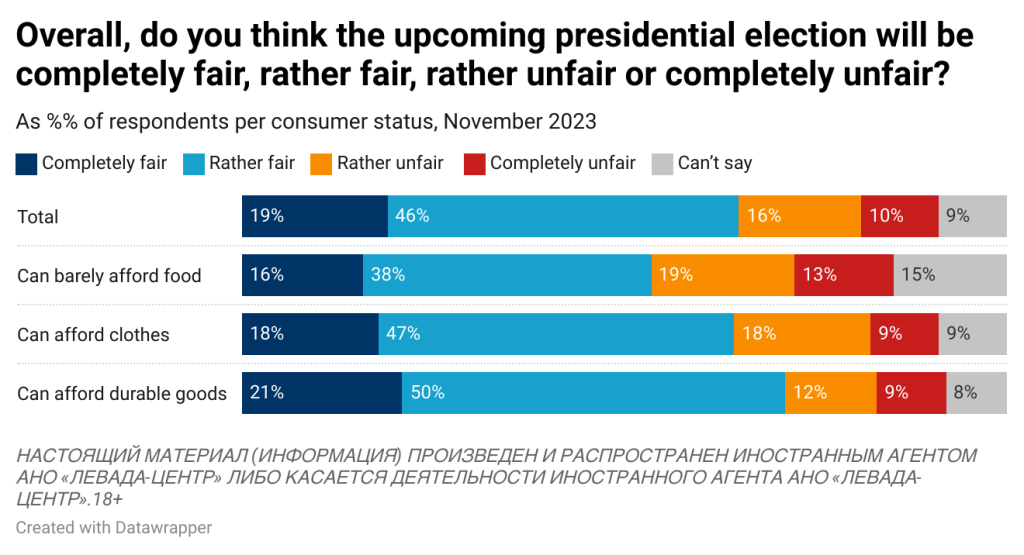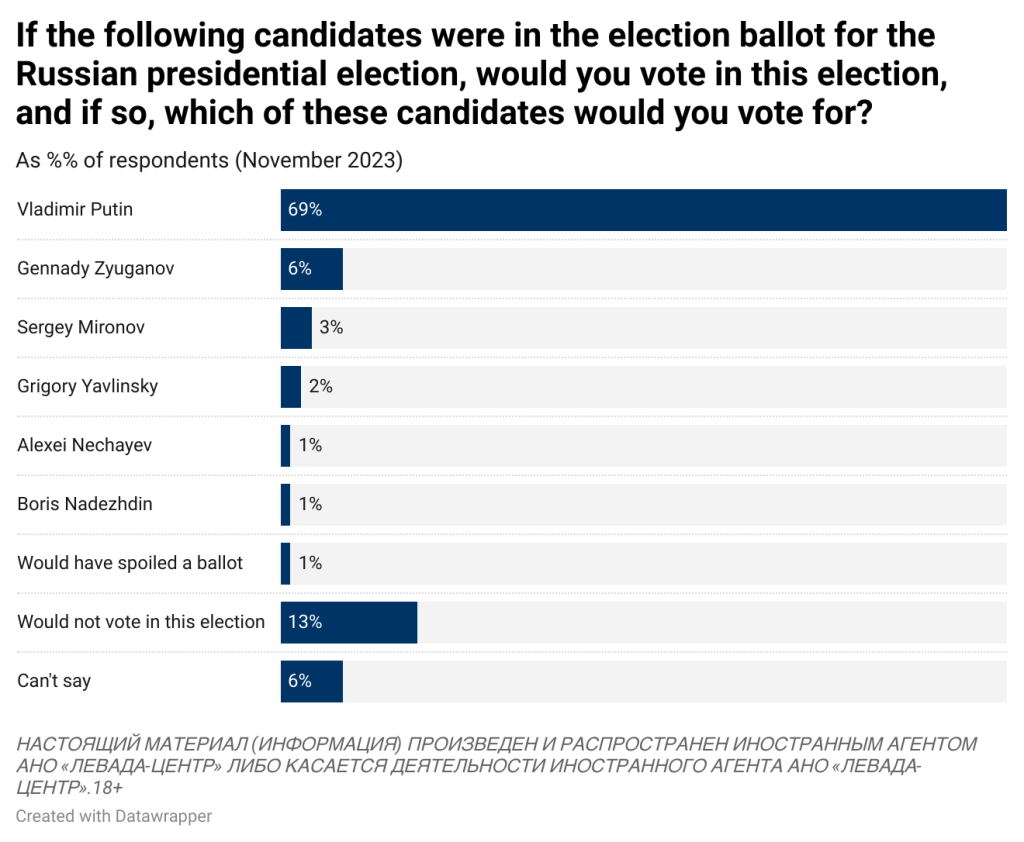Half of the respondents know about the upcoming presidential elections next year. About two thirds of the respondents expressed their willingness to vote. If the presidential elections had been held next Sunday, Vladimir Putin would have received the majority of votes. Similar indicators of support for the current president were observed after 2014 and in the mid-2000s. Most Russians would like to see Vladimir Putin as president after 2024, their share has increased sharply last year. Two thirds of Russians believe that the upcoming elections will be fair. This is more than in previous measurements.
About half of the respondents (56%) know that presidential elections are to be held next year. The level of awareness about the upcoming presidential elections is higher among older age groups: 55-64 years – 65%, 65 years and older – 64%.


Two thirds of Russians declare their intention to vote in the upcoming presidential elections: 33% are “definitely” going to vote and the same number are “likely to vote” (33%). A fifth of the respondents replied that they were not going to vote (10% “are sure that they will not vote” and the same number “doubt that they will vote”). Another 12% do not know whether they will vote or not. A similar distribution of responses was observed, for example, in early 2000 or early 2012.

The respondents who are not going to vote in the upcoming elections justify their position with the following reasons: “I don’t believe in the elections, it’s not fair, I don’t see the point” – 25%, “everything has already been decided without us, everything is known in advance, they will choose who they need” – 24%, “I don’t want, I don’t want, I’m not interested, I’m not interested politics” – 16%, “no time, a lot of things, I can leave, more important things” – 11%.

At the same time, two thirds of Russians (65%) believe that the upcoming elections will be fair (19% – completely honest, 46% – rather honest). This is the highest result compared to previous measurements in 2008, 2012 and 2018. About a quarter of respondents believe that the elections will be unfair today.
More often than others, the wealthiest Russians (71% among those who can afford durable goods), who trust the information of television channels (81%), and also believe that things in the country are going in the right direction (82%) believe that the upcoming elections will be fair.
The opposite opinion is more often held by the least well—off Russians (“can barely afford food” – 32%), who trust the information of YouTube channels (41%), as well as those who hold the opinion that the country is moving along the wrong path (64%).




The answers to the open question about whom Russians would vote for in the presidential election (no clues were offered, the respondents themselves named politicians) show the following distribution of preferences. The majority (58%) are ready to vote for Vladimir Putin. Another 1.3% of respondents would vote for Gennady Zyuganov, slightly less for Pavel Grudinin, Mikhail Mishustin and Leonid Slutsky.
At the same time, if the chosen candidate was not on the list, the majority (27%) would not be able to decide on a candidate, and 9% would not vote. And among those who named a second politician, Mikhail Mishustin was most often mentioned – 7%, Dmitry Medvedev in second place (3%). Less than 3% of the respondents named each of the other politicians.


Dynamic changes in the share of Vladimir Putin’s supporters (according to the open question) show that the willingness to vote for him has increased sharply against the background of consolidation of public opinion at the beginning of last year. Although today we are witnessing one of the peaks of support for Vladimir Putin, in the long term, the current situation does not look like something extraordinary. Similar peaks of support were observed in 2018, 2014-2015 and in 2003-2004.

The votes are distributed somewhat differently if respondents are offered a closed final list of candidates (which reproduces the situation of the ballot; in addition to Vladimir Putin, we included several federal politicians in this hypothetical ballot, including those who declared their readiness to participate in the elections at the time of the survey; we understand that the final ballot will look somewhat different). Choosing from the specified list of candidates, respondents even more often prefer Vladimir Putin — 69% of all respondents. Another 6% of respondents would vote for Gennady Zyuganov, 3% for Sergei Mironov, 2% for Grigory Yavlinsky, 1% for Boris Nadezhdin.
In terms of “those who have decided on their choice”, the votes are distributed as follows: 85% of potential voters are ready to support Vladimir Putin, Gennady Zyuganov — 7%, Sergei Mironov — 3%, Grigory Yavlinsky — 2%, Boris Nadezhdin — 1%.


The question of the desire to see Vladimir Putin as president after 2024 shows the same dynamics as on the open question. Support for the president grew last year against the background of public consolidation and today the majority (78%) would like to see Vladimir Putin as president of Russia at the end of his current presidential term. 15% of the respondents would not like to. A similar (though less pronounced) surge in support for the president was observed after February-March 2014.

The desire to see Vladimir Putin as president after 2024 is more often demonstrated by those who trust information from television (90%), believe that things are going in the right direction in the country (91%), and approve of the activities of V. Putin as president (90%).
Most often, respondents who trust information from YouTube channels (33%), believe that the country is moving along the wrong path (49%), and disapprove of the activities of the current president (77%) would not like to see Vladimir Putin as president after 2024.



METHODOLOGY
The all-Russian survey by the Levada Center was conducted November 23 – 29 2023, among a representative sample of all Russian urban and rural residents. The sample consisted of 1625 people aged 18 or older in 137 municipalities of 50 regions of the Russian Federation. The survey was conducted as a personal interview in respondents’ homes. The distribution of responses is given as a percentage of the total number of respondents.
The statistical error of these studies for a sample of 1600 people (with a probability of 0.95) does not exceed:
3.4% for indicators around 50%
2.9% for indicators around 25%/75%
2.0% for indicators around 10%/90%
1.5% for indicators around 5%/95%


